201771010102 常惠琢 《2018面向对象程序设计(Java)》第9周学习总结
Posted hongyanohongyan
tags:
篇首语:本文由小常识网(cha138.com)小编为大家整理,主要介绍了201771010102 常惠琢 《2018面向对象程序设计(Java)》第9周学习总结相关的知识,希望对你有一定的参考价值。
实验九 异常、断言与日志
实验时间 2018-10-25
1、实验目的与要求
(1) 掌握java异常处理技术;
(2) 了解断言的用法;
(3) 了解日志的用途;
(4) 掌握程序基础调试技巧;
2、实验内容和步骤
实验1:用命令行与IDE两种环境下编辑调试运行源程序ExceptionDemo1、ExceptionDemo2,结合程序运行结果理解程序,掌握未检查异常和已检查异常的区别。
|
//异常示例1 public class ExceptionDemo1 { public static void main(String args[]) { int a = 0; System.out.println(5 / a); } } |
|
//异常示例2 import java.io.*;
public class ExceptionDemo2 { public static void main(String args[]) { FileInputStream fis=new FileInputStream("text.txt");//JVM自动生成异常对象 int b; while((b=fis.read())!=-1) { System.out.print(b); } fis.close(); } } |
1 public class ExceptionDemo1 { 2 3 public static void main(String[] args) { 4 5 int a = 0; 6 if (a==0) { 7 System.out.println("除数为零"); 8 } else { 9 System.out.println(5 / a); 10 } 11 } 12 }
//消极处理方式 import java.io.*; public class ExceptionDemo2 { public static void main(String args[]) throws Exception { //以字节流打开未正常打开,字符流打开是可以正常打开。 FileInputStream fis=new FileInputStream("text.txt");//JVM自动生成异常对象 int b; while((b=fis.read())!=-1) { System.out.print(b); } fis.close(); } }
//积极的异常处理 import java.io.*; public class ExceptionDemo { public static void main(String args[]) { FileInputStream fis; try { fis = new FileInputStream("text.txt"); //JVM自动生成异常对象 int b; while((b=fis.read())!=-1) { System.out.print(b); } fis.close(); } catch (Exception e) {//e.printStackTrace(); // System.out.println("Hello."); } } }

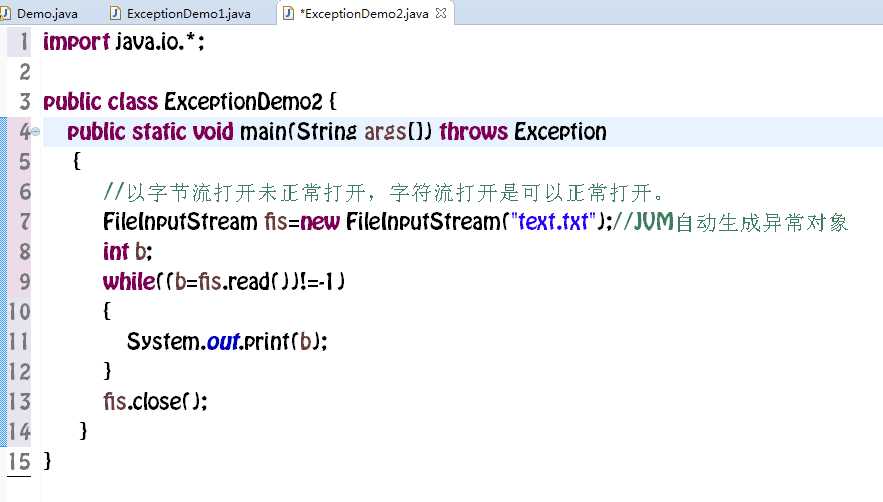



实验2: 导入以下示例程序,测试程序并进行代码注释。
测试程序1:
l 在elipse IDE中编辑、编译、调试运行教材281页7-1,结合程序运行结果理解程序;
l 在程序中相关代码处添加新知识的注释;
l 掌握Throwable类的堆栈跟踪方法
package stackTrace; import java.util.*; /** * 一种显示递归方法调用的跟踪特征的程序。 * A program that displays a trace feature of a recursive method call. * @version 1.01 2004-05-10 * @author Cay Horstmann */ public class StackTraceTest { /** * Computes the factorial of a number 计算一个数的阶乘 * @param n a non-negative integer 非负整数的PARAM * @return n! = 1 * 2 * . . . * n */ public static int factorial(int n) { System.out.println("factorial(" + n + "):"); Throwable t = new Throwable(); StackTraceElement[] frames = t.getStackTrace(); for (StackTraceElement f : frames) System.out.println(f); int r; if (n <= 1) r = 1; else r = n * factorial(n - 1); System.out.println("return " + r); return r; } public static void main(String[] args) { Scanner in = new Scanner(System.in); System.out.print("Enter n: "); int n = in.nextInt(); factorial(n); } }

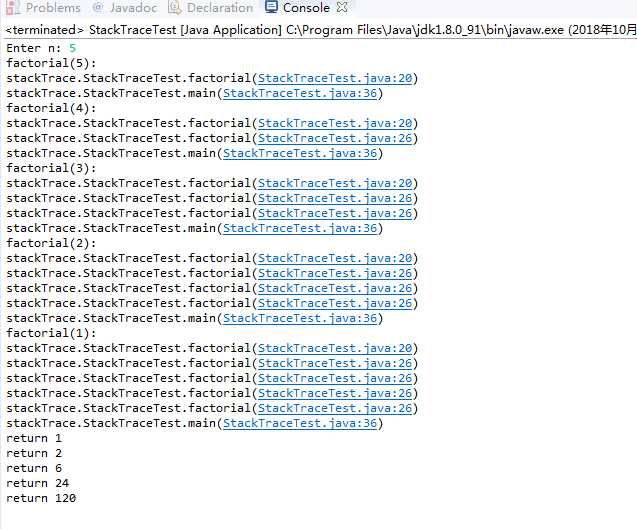
测试程序2:
l Java语言的异常处理有积极处理方法和消极处理两种方式;
l 下列两个简答程序范例给出了两种异常处理的代码格式。在elipse IDE中编辑、调试运行源程序ExceptionalTest.java,将程序中的text文件更换为身份证号.txt,要求将文件内容读入内容,并在控制台显示;
l 掌握两种异常处理技术的特点。
|
//积极处理方式 import java.io.*;
class ExceptionTest { public static void main (string args[]) { try{ FileInputStream fis=new FileInputStream("text.txt"); } catch(FileNotFoundExcption e) { …… } …… } } |
|
//消极处理方式
import java.io.*; class ExceptionTest { public static void main (string args[]) throws FileNotFoundExcption { FileInputStream fis=new FileInputStream("text.txt"); } } |
import java.io.BufferedReader; import java.io.FileInputStream; import java.io.FileNotFoundException; import java.io.IOException; import java.io.InputStreamReader; public class ExceptionTest { public static void main(String[] args) throws IOException { try { FileInputStream fis = new FileInputStream("身份证号.txt"); BufferedReader in = new BufferedReader(new InputStreamReader(fis)); String m, n = new String(); while ((m = in.readLine()) != null) { n += m + " "; } in.close(); System.out.println(n); } catch (FileNotFoundException e) { System.out.println("学生信息文件找不到"); e.printStackTrace(); } catch (IOException e) { System.out.println("学生信息文件读取错误"); e.printStackTrace(); } } }
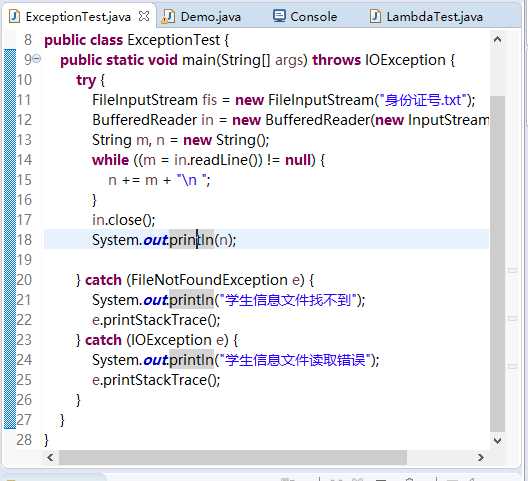

//消极处理方式 import java.io.*; public class ExceptionTest { public static void main (String args[]) throws IOException { File fis=new File("身份证号.txt"); FileReader fr = new FileReader(fis); BufferedReader br = new BufferedReader(fr); String s, s2 = new String(); while ((s = br.readLine()) != null) { s2 += s + " "; } br.close(); System.out.println(s2); } }
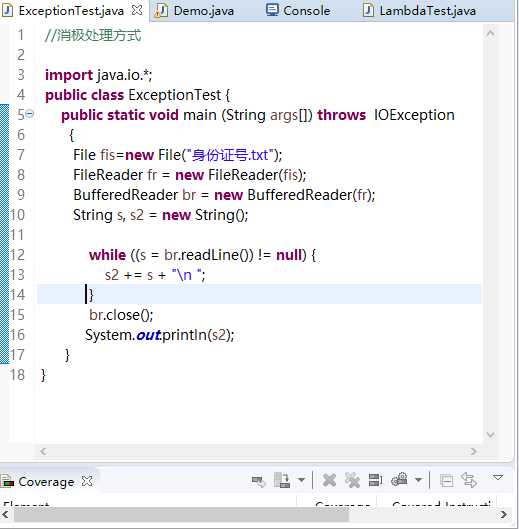
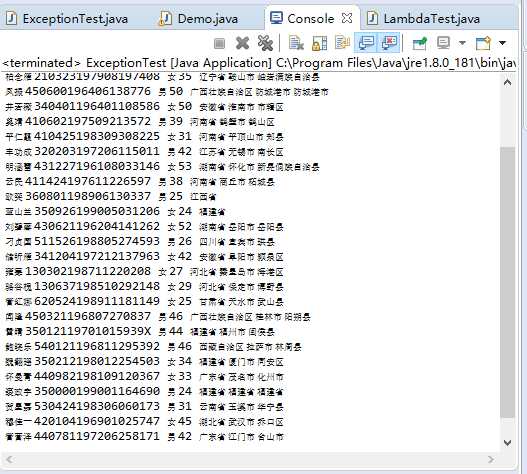
实验3: 编程练习
练习1:
l 编制一个程序,将身份证号.txt 中的信息读入到内存中;
l 按姓名字典序输出人员信息;
l 查询最大年龄的人员信息;
l 查询最小年龄人员信息;
l 输入你的年龄,查询身份证号.txt中年龄与你最近人的姓名、身份证号、年龄、性别和出生地;
l 查询人员中是否有你的同乡;
l 在以上程序适当位置加入异常捕获代码。
import java.io.BufferedReader; import java.io.File; import java.io.FileInputStream; import java.io.FileNotFoundException; import java.io.IOException; import java.io.InputStreamReader; import java.util.ArrayList; import java.util.Arrays; import java.util.Collections; import java.util.Scanner; public class Test { private static ArrayList<Student> studentlist; public static void main(String[] args) { studentlist = new ArrayList<>(); Scanner scanner = new Scanner(System.in); File file = new File("F:\\java\\身份证号.txt"); try { FileInputStream fis = new FileInputStream(file); BufferedReader in = new BufferedReader(new InputStreamReader(fis)); String temp = null; while ((temp = in.readLine()) != null) { Scanner linescanner = new Scanner(temp); linescanner.useDelimiter(" "); String name = linescanner.next(); String number = linescanner.next(); String sex = linescanner.next(); String age = linescanner.next(); String province =linescanner.nextLine(); Student student = new Student(); student.setName(name); student.setnumber(number); student.setsex(sex); int a = Integer.parseInt(age); student.setage(a); student.setprovince(province); studentlist.add(student); } } catch (FileNotFoundException e) { System.out.println("找不到学生的信息文件"); e.printStackTrace(); } catch (IOException e) { System.out.println("学生信息文件读取错误"); e.printStackTrace(); } boolean isTrue = true; while (isTrue) { System.out.println("选择你的操作, "); System.out.println("1.字典排序 "); System.out.println("2.输出年龄最大和年龄最小的人 "); System.out.println("3.寻找同乡 "); System.out.println("4.寻找年龄相近的人 "); System.out.println("5.退出 "); String m = scanner.next(); switch (m) { case "1": Collections.sort(studentlist); System.out.println(studentlist.toString()); break; case "2": int max=0,min=100; int j,k1 = 0,k2=0; for(int i=1;i<studentlist.size();i++) { j=studentlist.get(i).getage(); if(j>max) { max=j; k1=i; } if(j<min) { min=j; k2=i; } } System.out.println("年龄最大:"+studentlist.get(k1)); System.out.println("年龄最小:"+studentlist.get(k2)); break; case "3": System.out.println("地址?"); String find = scanner.next(); String place=find.substring(0,3); for (int i = 0; i <studentlist.size(); i++) { if(studentlist.get(i).getprovince().substring(1,4).equals(place)) System.out.println("同乡"+studentlist.get(i)); } break; case "4": System.out.println("年龄:"); int yourage = scanner.nextInt(); int near=agenear(yourage); int value=yourage-studentlist.get(near).getage(); System.out.println(""+studentlist.get(near)); break; case "5 ": isTrue = false; System.out.println("退出程序!"); break; default: System.out.println("输入有误"); } } } public static int agenear(int age) { int j=0,min=53,value=0,ok=0; for (int i = 0; i < studentlist.size(); i++) { value=studentlist.get(i).getage()-age; if(value<0) value=-value; if (value<min) { min=value; ok=i; } } return ok; } }
public class Student implements Comparable<Student> { private String name; private String number ; private String sex ; private int age; private String province; public String getName() { return name; } public void setName(String name) { this.name = name; } public String getnumber() { return number; } public void setnumber(String number) { this.number = number; } public String getsex() { return sex ; } public void setsex(String sex ) { this.sex =sex ; } public int getage() { return age; } public void setage(int age) { // int a = Integer.parseInt(age); this.age= age; } public String getprovince() { return province; } public void setprovince(String province) { this.province=province ; } public int compareTo(Student o) { return this.name.compareTo(o.getName()); } public String toString() { return name+" "+sex+" "+age+" "+number+" "+province+" "; } }
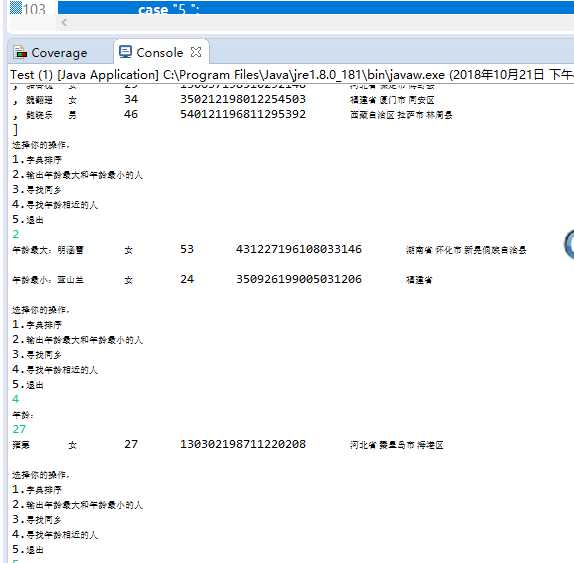
注:以下实验课后完成
练习2:
l 编写一个计算器类,可以完成加、减、乘、除的操作;
l 利用计算机类,设计一个小学生100以内数的四则运算练习程序,由计算机随机产生10道加减乘除练习题,学生输入答案,由程序检查答案是否正确,每道题正确计10分,错误不计分,10道题测试结束后给出测试总分;
l 将程序中测试练习题及学生答题结果输出到文件,文件名为test.txt;
l 在以上程序适当位置加入异常捕获代码。
package 异常; import java.io.FileNotFoundException; import java.io.PrintWriter; import java.util.Scanner; public class Demo { public static void main(String[] args, Object jf) { @SuppressWarnings("resource") Scanner in = new Scanner(System.in); jf counter=new jf(); PrintWriter out = null; try { out = new PrintWriter("text.txt"); } catch (FileNotFoundException e) { // TODO Auto-generated catch block e.printStackTrace(); } int sum = 0; for (int i = 1; i <=10; i++) { int a = (int) Math.round(Math.random() * 100); int b = (int) Math.round(Math.random() * 100); int m= (int) Math.round(Math.random() * 3); switch(m) { case 0: System.out.println(i+": "+a+"/"+b+"="); while(b==0){ b = (int) Math.round(Math.random() * 100); } int c0 = in.nextInt(); out.println(a+"/"+b+"="+c0); if (c0 == ((异常.jf) jf).division(a, b)) { sum += 10; System.out.println("恭喜答案正确"); } else { System.out.println("抱歉,答案错误"); } break; case 1: System.out.println(i+": "+a+"*"+b+"="); int c = in.nextInt(); out.println(a+"*"+b+"="+c); if (c == counter.multiplication(a, b)) { sum += 10; System.out.println("恭喜答案正确"); } else { System.out.println("抱歉,答案错误"); } break; case 2: System.out.println(i+": "+a+"+"+b+"="); int c1 = in.nextInt(); out.println(a+"+"+b+"="+c1); if (c1 == counter.add(a, b)) { sum += 10; System.out.println("恭喜答案正确"); } else { System.out.println("抱歉,答案错误"); } break ; case 3: System.out.println(i+": "+a+"-"+b+"="); int c2 = in.nextInt(); out.println(a+"-"+b+"="+c2); if (c2 == counter.reduce(a, b)) { sum += 10; System.out.println("恭喜答案正确"); } else { System.out.println("抱歉,答案错误"); } break ; } } System.out.println("成绩"+sum); out.println("成绩:"+sum); out.close(); } }
package 异常; public class jf { private int a; private int b; public int add(int a,int b) { return a+b; } public int reduce(int a,int b) { return a-b; } public int multiplication(int a,int b) { return a*b; } public int division(int a,int b) { if(b!=0) return a/b; else return 0; } }
实验4:断言、日志、程序调试技巧验证实验。
实验程序1:
|
//断言程序示例 public class AssertDemo { public static void main(String[] args) { test1(-5); test2(-3); }
private static void test1(int a){ assert a > 0; System.out.println(a); } private static void test2(int a){ assert a > 0 : "something goes wrong here, a cannot be less than 0"; System.out.println(a); } } |
在elipse下调试程序AssertDemo,结合程序运行结果理解程序;
l 注释语句test1(-5);后重新运行程序,结合程序运行结果理解程序;
l 掌握断言的使用特点及用法。
//断言程序示例 public class AssertDemo { public static void main(String[] args) { test1(-5); test2(-3); } private static void test1(int a){ assert a > 0; System.out.println(a); } private static void test2(int a){ assert a > 0 : "something goes wrong here, a cannot be less than 0"; System.out.println(a); } }
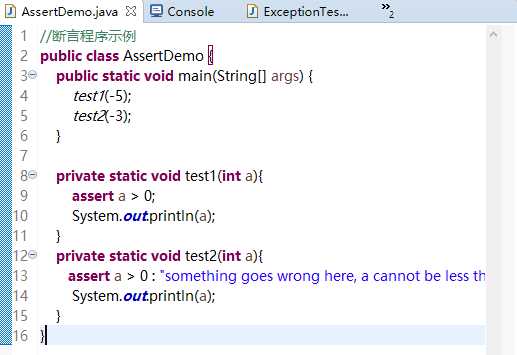

实验程序2:
l 用JDK命令调试运行教材298页-300页程序7-2,结合程序运行结果理解程序;
l 并掌握Java日志系统的用途及用法。
import java.awt.event.ActionEvent; import java.awt.event.ActionListener; import java.io.File; import java.util.logging.Level; import java.util.logging.Logger; import javax.swing.ImageIcon; import javax.swing.JFileChooser; import javax.swing.JFrame; import javax.swing.JLabel; import javax.swing.JMenu; import javax.swing.JMenuBar; import javax.swing.JMenuItem; /** * The frame that shows the image. */ class ImageViewerFrame extends JFrame { private static final int DEFAULT_WIDTH = 300; private static final int DEFAULT_HEIGHT = 400; private JLabel label; private static Logger logger = Logger.getLogger("com.horstmann.corejava"); public ImageViewerFrame() { logger.entering("ImageViewerFrame", "<init>"); setSize(DEFAULT_WIDTH, DEFAULT_HEIGHT); // set up menu bar JMenuBar menuBar = new JMenuBar(); setJMenuBar(menuBar); JMenu menu = new JMenu("File"); menuBar.add(menu); JMenuItem openItem = new JMenuItem("Open"); menu.add(openItem); openItem.addActionListener(new FileOpenListener()); JMenuItem exitItem = new JMenuItem("Exit"); menu.add(exitItem); exitItem.addActionListener(new ActionListener() { public void actionPerformed(ActionEvent event) { logger.fine("Exiting."); System.exit(0); } }); // use a label to display the images label = new JLabel(); add(label); logger.exiting("ImageViewerFrame", "<init>"); } private class FileOpenListener implements ActionListener { public void actionPerformed(ActionEvent event) { logger.entering("ImageViewerFrame.FileOpenListener", "actionPerformed", event); // set up file chooser JFileChooser chooser = new JFileChooser(); chooser.setCurrentDirectory(new File(".")); // accept all files ending with .gif chooser.setFileFilter(new javax.swing.filechooser.FileFilter() { public boolean accept(File f) { return f.getName().toLowerCase().endsWith(".gif") || f.isDirectory(); } public String getDescription() { return "GIF Images"; } }); // show file chooser dialog int r = chooser.showOpenDialog(ImageViewerFrame.this); // if image file accepted, set it as icon of the label if (r == JFileChooser.APPROVE_OPTION) { String name = chooser.getSelectedFile().getPath(); logger.log(Level.FINE, "Reading file {0}", name); label.setIcon(new ImageIcon(name)); } else logger.fine("File open dialog canceled."); logger.exiting("ImageViewerFrame.FileOpenListener", "actionPerformed"); } } }
import java.awt.*; import java.awt.event.*; import java.io.*; import java.util.logging.*; import javax.swing.*; /** * A modification of the image viewer program that logs various events. * @version 1.03 2015-08-20 * @author Cay Horstmann */ public class LoggingImageViewer { public static void main(String[] args) { if (System.getProperty("java.util.logging.config.class") == null && System.getProperty("java.util.logging.config.file") == null) { try { Logger.getLogger("com.horstmann.corejava").setLevel(Level.ALL); final int LOG_ROTATION_COUNT = 10; Handler handler = new FileHandler("%h/LoggingImageViewer.log", 0, LOG_ROTATION_COUNT); Logger.getLogger("com.horstmann.corejava").addHandler(handler); } catch (IOException e) { Logger.getLogger("com.horstmann.corejava").log(Level.SEVERE, "Can‘t create log file handler", e); } } EventQueue.invokeLater(() -> { Handler windowHandler = new WindowHandler(); windowHandler.setLevel(Level.ALL); Logger.getLogger("com.horstmann.corejava").addHandler(windowHandler); JFrame frame = new ImageViewerFrame(); frame.setTitle("LoggingImageViewer"); frame.setDefaultCloseOperation(JFrame.EXIT_ON_CLOSE); Logger.getLogger("com.horstmann.corejava").fine("Showing frame"); frame.setVisible(true); }); } }
import java.util.logging.LogRecord; import java.util.logging.StreamHandler; import javax.swing.JFrame; import javax.swing.JScrollPane; import javax.swing.JTextArea; import org.omg.CORBA.Any; import org.omg.CORBA.Object; import org.omg.CORBA.TypeCode; import org.omg.CORBA.portable.InputStream; import org.omg.CORBA_2_3.portable.OutputStream; /** * A handler for displaying log records in a window. */ class WindowHandler extends StreamHandler { private JFrame frame; public WindowHandler() { frame = new JFrame(); final JTextArea output = new JTextArea(); output.setEditable(false); frame.setSize(200, 200); frame.add(new JScrollPane(output)); frame.setFocusableWindowState(false); frame.setVisible(true); setOutputStream(new OutputStream() { public void write(int b) { } // not called public void write(byte[] b, int off, int len) { output.append(new String(b, off, len)); } @Override public InputStream create_input_stream() { // TODO Auto-generated method stub return null; } @Override public void write_Object(Object arg0) { // TODO Auto-generated method stub } @Override public void write_TypeCode(TypeCode arg0) { // TODO Auto-generated method stub } @Override public void write_any(Any arg0) { // TODO Auto-generated method stub } @Override public void write_boolean(boolean arg0) { // TODO Auto-generated method stub } @Override public void write_boolean_array(boolean[] arg0, int arg1, int arg2) { // TODO Auto-generated method stub } @Override public void write_char(char arg0) { // TODO Auto-generated method stub } @Override public void write_char_array(char[] arg0, int arg1, int arg2) { // TODO Auto-generated method stub } @Override public void write_double(double arg0) { // TODO Auto-generated method stub } @Override public void write_double_array(double[] arg0, int arg1, int arg2) { // TODO Auto-generated method stub } @Override public void write_float(float arg0) { // TODO Auto-generated method stub } @Override public void write_float_array(float[] arg0, int arg1, int arg2) { // TODO Auto-generated method stub } @Override public void write_long(int arg0) { // TODO Auto-generated method stub } @Override public void write_long_array(int[] arg0, int arg1, int arg2) { // TODO Auto-generated method stub } @Override public void write_longlong(long arg0) { // TODO Auto-generated method stub } @Override public void write_longlong_array(long[] arg0, int arg1, int arg2) { // TODO Auto-generated method stub } @Override public void write_octet(byte arg0) { // TODO Auto-generated method stub } @Override public void write_octet_array(byte[] arg0, int arg1, int arg2) { // TODO Auto-generated method stub } @Override public void write_short(short arg0) { // TODO Auto-generated method stub } @Override public void write_short_array(short[] arg0, int arg1, int arg2) { // TODO Auto-generated method stub } @Override public void write_string(String arg0) { // TODO Auto-generated method stub } @Override public void write_ulong(int arg0) { // TODO Auto-generated method stub } @Override public void write_ulong_array(int[] arg0, int arg1, int arg2) { // TODO Auto-generated method stub } @Override public void write_ulonglong(long arg0) { // TODO Auto-generated method stub } @Override public void write_ulonglong_array(long[] arg0, int arg1, int arg2) { // TODO Auto-generated method stub } @Override public void write_ushort(short arg0) { // TODO Auto-generated method stub } @Override public void write_ushort_array(short[] arg0, int arg1, int arg2) { // TODO Auto-generated method stub } @Override public void write_wchar(char arg0) { // TODO Auto-generated method stub } @Override public void write_wchar_array(char[] arg0, int arg1, int arg2) { // TODO Auto-generated method stub } @Override public void write_wstring(String arg0) { // TODO Auto-generated method stub } }); } public void publish(LogRecord record) { if (!frame.isVisible()) return; super.publish(record); flush(); } }
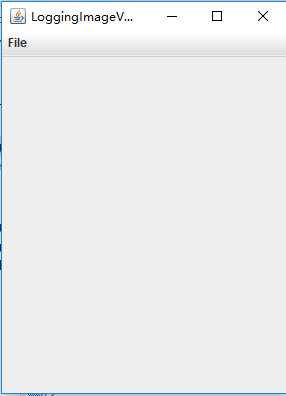
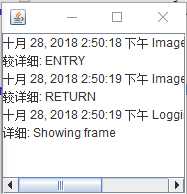
实验总结:
第7章 异常、日志、断言和调试:
?概念:异常、异常类型、异常声明、异常抛出、 异常捕获
?异常处理技术
?断言的概念及使用
?基本的调试技巧
一、异常的概念:
Java的异常处理机制可以控制程序从错误产生的 位置转移到能够进行错误处理的位置。 ?
程序中出现的常见的错误和问题有:
用户输入错误
设备错误
物理限制
代码错误
二、异常分类:
?Java把程序运行时可能遇到的错误分为两类:
1、非致命异常:通过某种修正后程序还能继续执行。 这类错误叫作异常。如:文件不存在、无效的数组 下标、空引用、网络断开、打印机脱机、磁盘满等。 Java中提供了一种独特的处理异常的机制,通过异 常来处理程序设计中出现的错误。
2、致命异常:程序遇到了非常严重的不正常状态,不 能简单恢复执行,是致命性错误。如:内存耗尽、 系统内部错误等。这种错误程序本身无法解决。
?Java中所有的异常类都直接或间接地继承于 Throwable类。除内置异常类外,程序员可自定义异 常类。 ?
3、Java中的异常类可分为两大类:
-Error Error类层次结构描述了Java运行时系统的内部错误 和资源耗尽错误。应用程序不应该捕获这类异常,也 不会抛出这种异常。
-Exception Exception类:重点掌握的异常类。Exception层次结 构又分解为两个分支:一个分支派生于 RuntimeException;另一个分支包含其他异常。
4、RuntimeException为运行时异常类,一般是程序错误 产生。 ?
派生于RuntimeException的异常包含下面几种情况:
–错误的类型转换 –数组访问越界
–访问空指针
–Java将派生于Error类或RuntimeException类的所有异 常称为未检查异常,编译器允许不对它们做出异常处 理。
注意:“如果出现RuntimeException异常,就一定是程序员 的问题!!!”
5、非运行时异常,程序本身没有问题,但由于某种情 况的变化,程序不能正常运行,导致异常出现。 ?除了运行时异常之外的其它继承自Exception类的 异常类包括:
–试图在文件尾部后面读取数据 –试图打开一个错误格式的URL
–编译器要求程序必须对这类异常进行处理 (checked),称为已检查异常。
RuntimeException: 运行时异常类
–ArithmeticException: 算术异常类
–ArrayStoreException: 数组存储异常类
–ClassCastException: 类型强制转换异常类
–IndexOutOfBoundsException: 下标越界异常类
–NullPointerException: 空指针异常类
–SecurityException: 违背安全原则异常类
IOException:输入输出异常类
–IOException:申请I/O操作没有正常完成。
–EOFException:在输入操作正常结束前遇见了 文件结束符。
–FileNotFountException:在文件系统中,没有找到由文件名字符串指定的文件。
小结:异常类型:
1>.Error 很难恢复的严重错误,一般不由程序处理。
?2>.RuntimeException 程序设计或实现上的问题,如数组越界等。
?3>.其它异常 通常是由环境因素引起的,并且可以被处理。 如文件不存在,无效URL等。
以上是关于201771010102 常惠琢 《2018面向对象程序设计(Java)》第9周学习总结的主要内容,如果未能解决你的问题,请参考以下文章